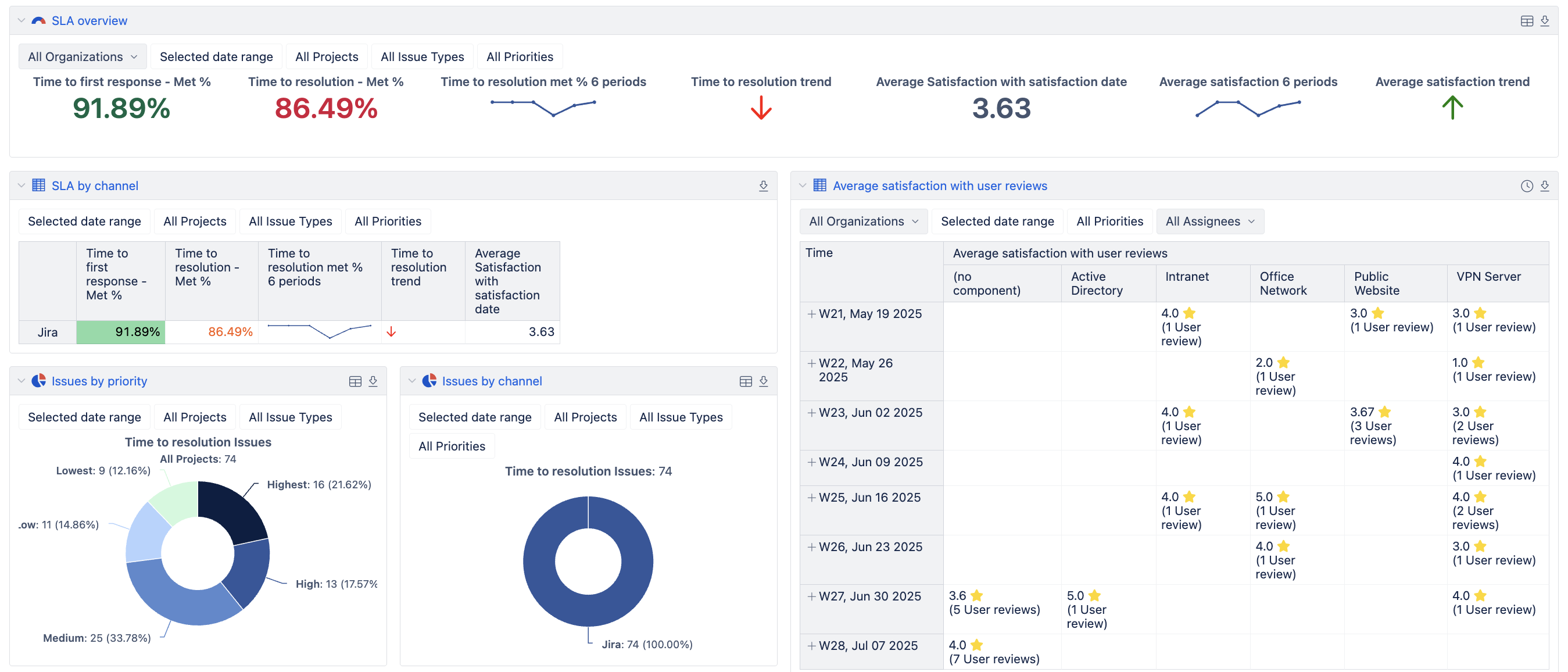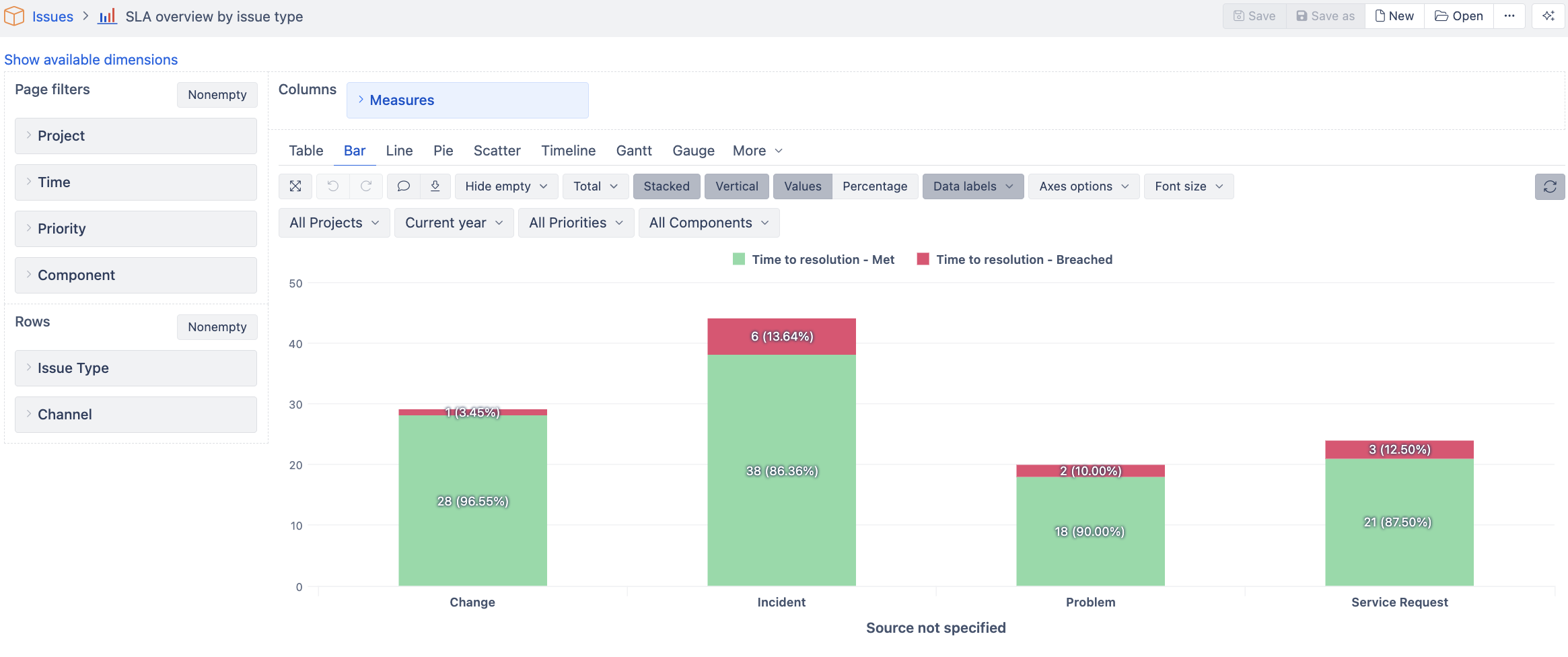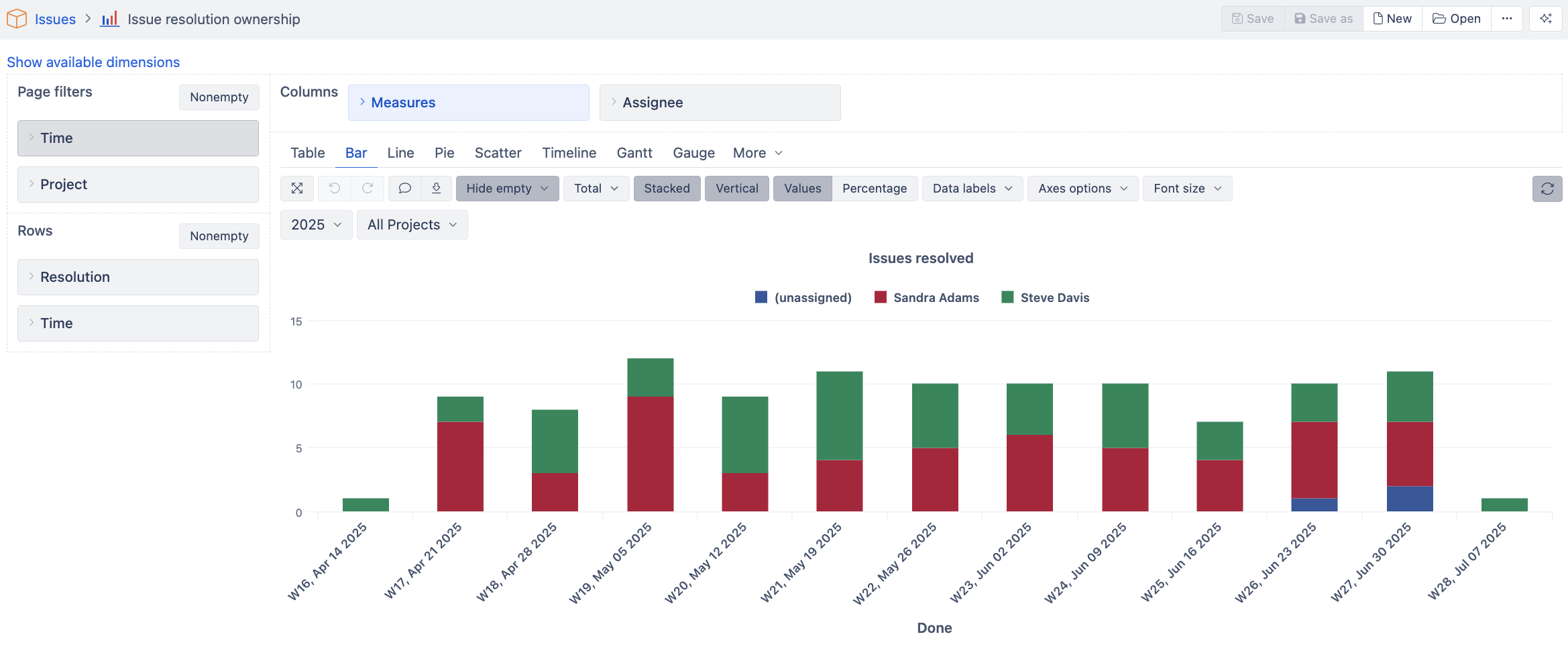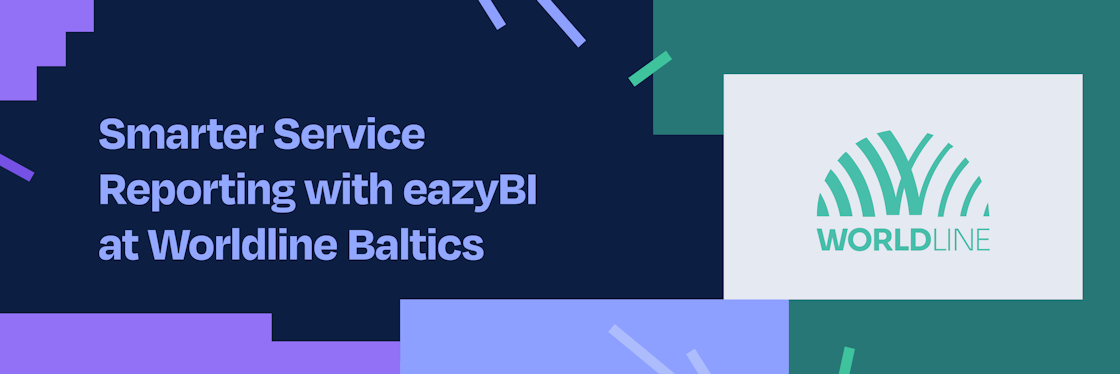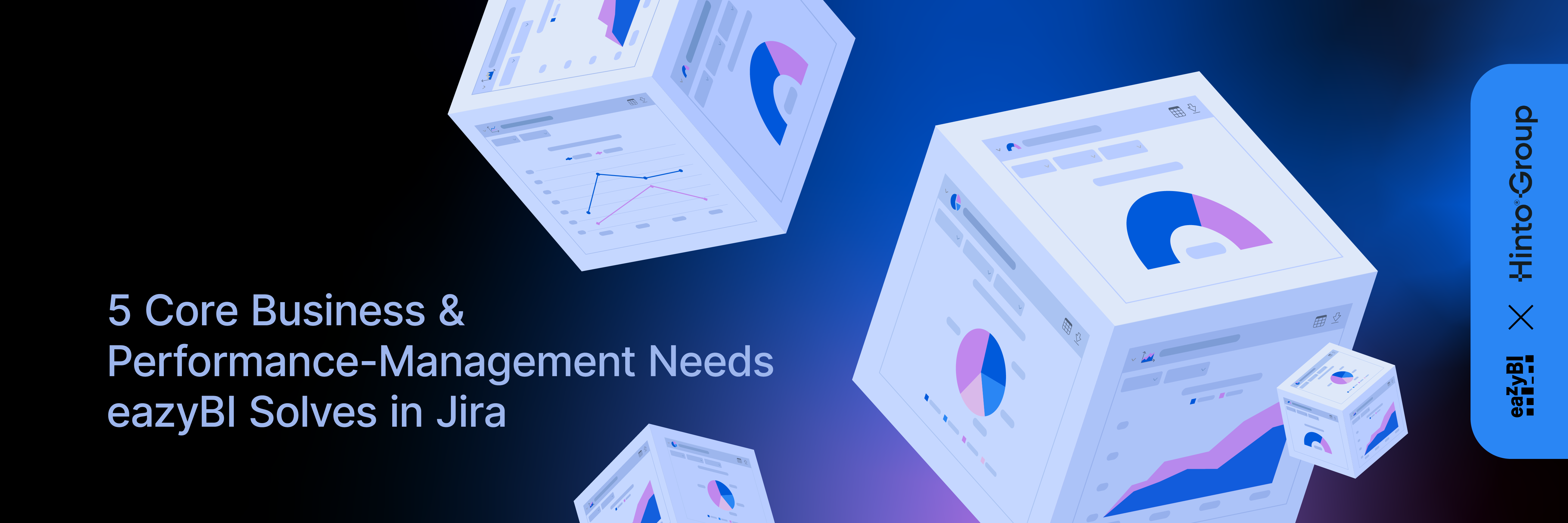

5 Performance-Management Needs eazyBI Solves in Jira
In today’s business landscape, where teams are distributed across departments and geographies, performance management and service visibility are critical. For organizations using Atlassian tools, especially Jira, managing SLAs, vendor accountability, and internal KPIs can be challenging without advanced reporting.
While Jira offers native dashboards, they lack the depth needed for cross-project reporting, custom KPIs, and regulatory compliance metrics—all crucial for scaling operations or meeting standards like EU DORA. That’s where eazyBI for Jira becomes essential: a powerful Jira reporting plugin that transforms raw data into actionable business intelligence.
With years of experience implementing BI solutions in Atlassian environments, we have identified 5 core performance and reporting needs that eazyBI helps organizations address directly within their Jira suite.
Business need 1: Clarity and Performance Management Across Distributed Teams
A major banking and financial institution approached Hinto®Group to improve performance management across its diverse internal teams. With multiple branches spread across the country, they found it hard to compare results, understand support issues, and gain a clear, consolidated view of how each team was performing.
They also faced challenges in tracking the profitability of activities across different locations: Was one office slower at resolving issues? Were certain types of tasks consuming more resources than expected? They needed a centralized solution to easily compare outputs, monitor task execution across offices, and make informed decisions about resource allocation—without navigating dozens of fragmented Jira boards.
How eazyBI helped: By integrating data from multiple Jira projects into centralized, customized dashboards, eazyBI enabled clear visibility into team workloads, project delays, and resource needs to maintain efficiency. Custom measures allowed organizations to analyze time logged against tasks, correlate it with cost structures, and detect performance trends. Managers could quickly identify where additional staff were needed, assess which activities required disproportionate time and effort, and determine opportunities for process digitization.
Business need 2: Service Control, Vendor Accountability, and SLA Monitoring
In service-based organizations, both internal teams and external vendors must meet strict SLAs (Service Level Agreements). While working closely with clients in the manufacturing and retail sectors, we found that managers often struggle to detect SLA disruptions—or even breaches—early enough to prevent negative impacts on their teams and KPIs. Missing a deadline can result in financial penalties, while inaccurate estimates of time or deliverables can significantly affect team performance.
How eazyBI helped: By building reports focused on SLA compliance, teams could monitor ticket aging, track vendor response times, and identify delay patterns—before they escalated into penalties. Some companies extended beyond by integrating external suppliers' Jira projects, enabling a comprehensive view of service delivery within a single dashboard.
Business Need 3: Catching and Managing "Out-of-Process" Requests
In complex IT environments, service teams often face difficulties managing "out-of-process" requests and help desk incidents that fall outside of standard workflows. Without a clear system to track and categorize them, these recurrent requests can go unnoticed, leading to inefficiencies, missed opportunities for automation, and reduced service quality. This challenge was particularly evident for a university working with Hinto®Group, where a mix of tools, including asset management platforms and sensors, generated a high volume of tickets lacking a clear structure in the requests.
Similarly, a retail and manufacturing client of ours reportedly had issues with too many issues being escalated to external consultants, driving up costs. Management required further information to be able to understand and identify which kind of problems really required external help, and which ones could be solved internally.
How eazyBI helped: Integrating these tools with Jira and channeling structured incident data into eazyBI, the university was able to gain a comprehensive view of internal tickets and request reports. eazyBI enabled the creation of targeted reports that tracked both standard and non-standard request types across service teams. By tracking helpdesk incidents by type, source, and resolution method, they could identify common patterns. This insight allowed them to train internal teams, create automation, or even deploy knowledge base entries, reducing reliance on external 3 consultants over time. This data-driven visibility helped IT managers identify recurring problems, streamline service operations, and reduce pressure on support teams.
Business Need 4: Incident Reporting and Asset Visibility for DORA Compliance
With the introduction of the EU DORA (Digital Operational Resilience Act), financial institutions are under pressure to demonstrate robust incident and asset management capabilities. A client working with Hinto®Group needed to produce incident reports that went beyond help desk tickets, answering key regulatory and operational questions: When did it happen? Why? How fast did we react? Was it resolved correctly? Moreover, these reports needed to be accurate, high-level, and always up to date.
The challenge was rooted in how incidents don’t only originate from Jira. In complex infrastructures, data comes from various sources such as asset management platforms, monitoring tools, and external sensors, making it difficult to assemble a complete and timely view of operational resilience.
How eazyBI helped: Using eazyBI’s external data import capabilities, the institution integrated asset and monitoring data into their reporting dashboards. Combining this with Jira ticket data, they gained a unified, real-time view of service health that connected human incidents with system alerts and performance metrics.
Custom reports featuring timeline analysis, root cause tagging, and resolution ownership enabled the automatic generation of regulatory- and board-level summaries, drastically reducing the manual effort previously required for compliance reporting. This structured, end-to-end visibility also made it significantly easier to meet DORA compliance requirements by ensuring incidents could be tracked, categorized, and reported with full transparency and auditability.
Business Need 5: Tailored Reporting for Diverse Roles and External Stakeholders Accessible Outside of Jira
With many of our clients, the fact that different stakeholders need different insights from the same underlying data has been clearly established. Executives focus on strategic KPIs while Team leads want operational overviews. Service managers, however, monitor SLA adherence, whilst board members and external collaborators may need highly specific, high-level data. Many of these stakeholders, however, rarely have access to Jira. One report doesn’t fit all, and most tools don't support personalized, role-based visibility or external sharing without additional licenses.
How eazyBI helped: eazyBI made it possible to generate personalized, role-specific reports from the same shared data source. Using its flexible report builder, organizations created dashboards tailored to each audience, from executive summaries to team-level task breakdowns, and scheduled delivery on a weekly, monthly, or annual basis, depending on stakeholder needs.
Reports could be embedded directly into customer-facing portals, such as a Work Board, making them easily accessible to the right people in the right context. For highly targeted use cases, small, focused reports could be created to show only specific data sets, visible only to selected groups, proven to be ideal for showing a supplier their SLAs or a department their backlog.
Most importantly, eazyBI helped bypass Jira’s licensing restrictions. With public sharing links, selected reports could be published securely, allowing stakeholders without a Jira license to view the data they needed — without exposing the full Jira environment or increasing licensing costs.
Conclusions
As enterprises grow in size and complexity, their needs for advanced Jira reporting, real-time performance dashboards, and compliance-ready metrics. Whether it’s monitoring SLAs, managing distributed teams, or ensuring DORA compliance for financial institutions, native Jira tools alone aren't enough.
eazyBI bridges this gap by turning Jira into a robust business intelligence platform. It enables organizations to build custom Jira dashboards for team leads, executives, and external stakeholders — all from the same underlying data. With support for external data import, multi-project visibility, and secure dashboard sharing for non-Jira users, eazyBI helps you unlock the full potential of your Atlassian investment.

